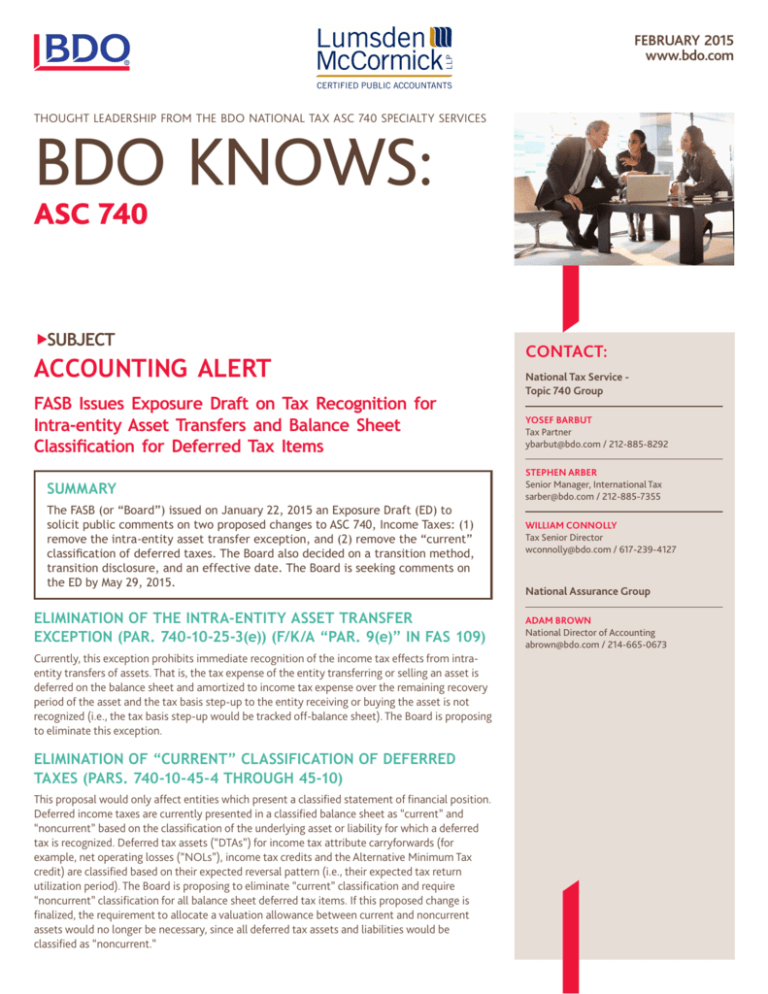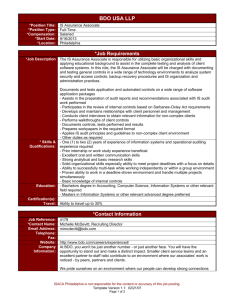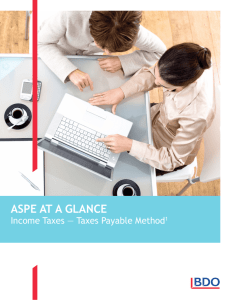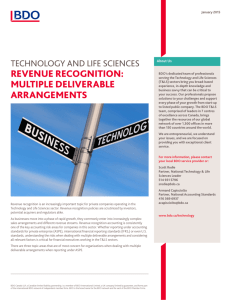
FEBRUARY 2015
www.bdo.com
THOUGHT LEADERSHIP FROM THE BDO NATIONAL TAX ASC 740 SPECIALTY SERVICES
BDO KNOWS:
ASC 740
SUBJECT
ACCOUNTING ALERT
FASB Issues Exposure Draft on Tax Recognition for
Intra-entity Asset Transfers and Balance Sheet
Classification for Deferred Tax Items
SUMMARY
The FASB (or “Board”) issued on January 22, 2015 an Exposure Draft (ED) to
solicit public comments on two proposed changes to ASC 740, Income Taxes: (1)
remove the intra-entity asset transfer exception, and (2) remove the “current”
classification of deferred taxes. The Board also decided on a transition method,
transition disclosure, and an effective date. The Board is seeking comments on
the ED by May 29, 2015.
ELIMINATION OF THE INTRA-ENTITY ASSET TRANSFER
EXCEPTION (PAR. 740-10-25-3(e)) (F/K/A “PAR. 9(e)” IN FAS 109)
Currently, this exception prohibits immediate recognition of the income tax effects from intraentity transfers of assets. That is, the tax expense of the entity transferring or selling an asset is
deferred on the balance sheet and amortized to income tax expense over the remaining recovery
period of the asset and the tax basis step-up to the entity receiving or buying the asset is not
recognized (i.e., the tax basis step-up would be tracked off-balance sheet). The Board is proposing
to eliminate this exception.
ELIMINATION OF “CURRENT” CLASSIFICATION OF DEFERRED
TAXES (PARS. 740-10-45-4 THROUGH 45-10)
This proposal would only affect entities which present a classified statement of financial position.
Deferred income taxes are currently presented in a classified balance sheet as “current” and
“noncurrent” based on the classification of the underlying asset or liability for which a deferred
tax is recognized. Deferred tax assets (“DTAs”) for income tax attribute carryforwards (for
example, net operating losses (“NOLs”), income tax credits and the Alternative Minimum Tax
credit) are classified based on their expected reversal pattern (i.e., their expected tax return
utilization period). The Board is proposing to eliminate “current” classification and require
“noncurrent” classification for all balance sheet deferred tax items. If this proposed change is
finalized, the requirement to allocate a valuation allowance between current and noncurrent
assets would no longer be necessary, since all deferred tax assets and liabilities would be
classified as “noncurrent.”
CONTACT:
National Tax Service Topic 740 Group
YOSEF BARBUT
Tax Partner
ybarbut@bdo.com / 212-885-8292
STEPHEN ARBER
Senior Manager, International Tax
sarber@bdo.com / 212-885-7355
WILLIAM CONNOLLY
Tax Senior Director
wconnolly@bdo.com / 617-239-4127
National Assurance Group
ADAM BROWN
National Director of Accounting
abrown@bdo.com / 214-665-0673
BDO KNOWS: ASC 740
TRANSITION METHOD
The Board is proposing a modified retrospective transition with a
cumulative catch-up adjustment to opening retained earnings for
the first proposal (the elimination of the intra-entity asset transfer
exception), and a prospective transition period for the second
proposal (the elimination of “current” classification).
TRANSITION DISCLOSURE
With respect to the first proposal, all entities will be required to
disclose (1) the nature and reason for the change in accounting
principle, (2) the cumulative effect to be recognized in the adoption
year through an adjustment to opening retained earnings (for
deferred tax charges existing as of the adoption date), (3) the effect
on the year of adoption’s results (i.e., tax expense with the intraentity transfer exception vs. tax expense without the intra-entity
transfer exception) and any affected per-share amounts for the
current year. Public entities must provide the disclosures in the
annual period in which they adopt the proposal and in the interim
periods within that annual period. Private entities must provide the
disclosures in the annual period in which they adopt the proposal.
With respect to the second proposal, all entities would be required
to disclose (1) the nature of and reason for the change in accounting
principle, and (2) that prospective adoption of “noncurrent”
classification results in a lack of comparability with prior periods.
This requirement is met by including a statement that prior periods
were not restated to remove “current” classification of deferred
taxes. Public entities must provide the disclosures in the annual
period of adoption and in the first interim period within that year.
Private entities must provide the disclosures in the annual period
of adoption.
EFFECTIVE DATE
Public entities’ effective date is the annual and interim periods,
beginning after December 15, 2016. Private entities will have an
additional year to adopt the proposals with respect to annual
reports (i.e., annual periods beginning after December 15, 2017) and
another year after adoption to take the proposals into account for
interim reports (i.e., interim periods beginning after December 15,
2018). Private entities will be allowed to early-adopt the proposals
(same period applicable to public entities). However, public entities
are not allowed early adoption.
ADDITIONAL BACKGROUND
The key argument for proposing to remove the exception for
intra-entity transfer of assets is the purported complexity when
intangible assets are transferred or sold in intra-entity transactions.
For example, intra-entity transfer of indefinite-lived intangible
assets and goodwill may trigger a net tax effect to be deferred on
the balance sheet and amortized into income tax expense over
the remaining amortization period (if any) or economic useful life.
When the intangible asset or goodwill is not amortized for book
or tax, the deferred tax charge is either suspended indefinitely
or until the asset is impaired or disposed of. Another question in
practice is whether the release of a valuation allowance occurring
in conjunction with intra-entity transfers should also be suspended.
Further, there is an argument that the recognition of the income tax
effects from intra-entity asset transfers in the period in which the
2
transfer occurs is a better reflection of the economic consequences
compared to current accounting.
The Board believes that recognition of current income tax paid
or payable would better enable users to compare current tax
expense and the effective tax rate to cash paid for income taxes.
However, the ED acknowledges that the elimination of the
recognition exception for intra-entity transfers of assets might
(a) necessitate making changes in processes and systems to track
additional temporary differences and (b) introduce greater volatility
in earnings. The Board nevertheless believes that removing the
exception is more beneficial than providing incremental
clarifying guidance.
The reason for proposing “noncurrent” classification of all deferred
taxes is to simplify the presentation of deferred taxes and thus
reduce complexity. The Board noted the classification requirement
does not provide useful information because it “generally does
not reflect when a temporary difference will reverse and become
a taxable or deductible item.” Therefore, “current” classification
of deferred taxes is not always an accurate estimate of deferred
tax balances expected to reverse within the next accounting
period. Additionally, some preparers question the usefulness of
the “pro rata” allocation of valuation allowance between current
and noncurrent gross DTAs when only some (but not all) deferred
tax balances require a valuation allowance (e.g., a capital loss
carryforward or a particular state or foreign country net operating
loss carryforward).
BDO COMMENTS
BDO supports initiatives to reduce or eliminate unnecessary
complexity from current U.S. GAAP. However, we question whether
other areas in Topic 740 might warrant relief for a wider population
of entities - for example, addressing common practice issues
associated with valuation allowances and uncertain tax positions
(“FIN 48 liabilities”).
Stakeholders are encouraged to submit comment letters by the
May 29, 2015 deadline.
The Tax Practice at BDO is among the largest tax advisory
practices in the United States. With 58 offices and more than 400
independent alliance firm locations in the United States, BDO has
the bench strength and coverage to serve you.
BDO is the brand name for BDO USA, LLP, a U.S. professional
services firm providing assurance, tax, financial advisory and
consulting services to a wide range of publicly traded and privately
held companies. For more than 100 years, BDO has provided
quality service through the active involvement of experienced and
committed professionals. The firm serves clients through 58 offices
and more than 400 independent alliance firm locations nationwide.
As an independent Member Firm of BDO International Limited,
BDO serves multinational clients through a global network of 1,328
offices in 152 countries. BDO USA, LLP, a Delaware limited liability partnership, is the U.S.
member of BDO International Limited, a UK company limited by
guarantee, and forms part of the international BDO network of
independent member firms. BDO is the brand name for the BDO
network and for each of the BDO Member Firms.
Material discussed in this publication is meant to provide general
information and should not be acted on without professional advice tailored
to your individual needs.
© 2015 BDO USA, LLP. All rights reserved. www.bdo.com






